Electric vehicles (EVs) have rapidly become the poster child of a cleaner, greener future. With no tailpipe emissions and lower operating costs, they offer an attractive alternative to internal combustion engine vehicles. However, beneath the surface of this technological revolution lies a complex issue that’s gaining attention — battery recycling. While EVs promise sustainability, the handling and disposal of their lithium-ion batteries pose serious environmental and ethical challenges. For those looking to dispose of their older or electric vehicles responsibly, services like cash for scrap cars Brisbane QLD provide a helpful solution, but what happens beyond the car yard is what really matters.
The Complex Anatomy of EV Batteries
Electric cars rely on powerful lithium-ion batteries made up of valuable and rare elements like lithium, cobalt, and nickel. These materials are essential for the batteries’ performance but are difficult and resource-intensive to extract. Once an EV battery reaches the end of its lifecycle — typically after 8 to 15 years — it becomes a potential environmental hazard if not disposed of or recycled properly.
Unlike traditional car parts, EV batteries cannot be simply thrown away. They require specialized recycling processes, which are still evolving. This creates a bottleneck in the electric car lifecycle that contradicts the idea of environmental responsibility.
The Environmental Cost of Extraction and Disposal
Mining for lithium, cobalt, and nickel is not only energy-intensive but also environmentally damaging. Vast amounts of water are used in the extraction process, and the mining operations often leave behind toxic byproducts. Additionally, many of the mines are located in ecologically sensitive or politically unstable regions, leading to further ethical concerns.
When these batteries are no longer usable, improper disposal can result in the leakage of hazardous chemicals into the soil and groundwater. Landfills are ill-equipped to handle such waste, and without a standardized battery recycling infrastructure, we’re risking long-term ecological damage.
Recycling Technologies: Still in Development
Battery recycling is not as straightforward as it may seem. While lead-acid car batteries have a recycling rate of over 95%, lithium-ion batteries lag far behind. The current recycling rate for EV batteries is estimated to be only 5% globally.
Technologies are emerging — such as pyrometallurgy (smelting) and hydrometallurgy (chemical leaching) — but they are energy-intensive and not yet efficient enough to handle the growing demand. Moreover, the inconsistency in battery design across EV manufacturers further complicates the recycling process.
A circular economy for EV batteries remains a vision rather than a reality. The infrastructure to support widespread, safe, and cost-effective battery recycling is still being built.
The Human Cost: Ethical Dilemmas
Another dark aspect of EV battery production is the ethical implications, especially around cobalt mining. A significant portion of the world’s cobalt supply comes from the Democratic Republic of Congo, where reports of child labor and unsafe working conditions are common.
While companies are pledging to source materials ethically and improve transparency, enforcement remains lax. Consumers may not realize that their green vehicle might be indirectly supporting exploitative labor practices. Responsible vehicle disposal, such as through services like cash for scrap cars Brisbane QLD, helps address local environmental concerns, but the global ethical implications require collective industry action.
Second Life vs. End of Life
One promising solution to the battery waste problem is repurposing old EV batteries for second-life applications. These include energy storage systems for homes and businesses, which can use batteries that are no longer suitable for cars but still retain up to 80% of their capacity.
However, second-life applications also come with challenges such as performance inconsistencies and liability concerns. Until comprehensive standards are established, this solution can only be partially relied upon.
The Role of Policy and Industry
Governments and automotive manufacturers must take proactive steps to address battery recycling. Regulatory frameworks need to enforce proper disposal and recycling standards, while incentivizing innovation in this space.
Automakers are beginning to take notice. Companies like Tesla, GM, and BMW have started investing in closed-loop battery recycling systems. These aim to recover valuable metals from old batteries and reuse them in new ones, reducing the need for fresh mining. Still, such initiatives are in their infancy and not yet widely adopted.
What Can Consumers Do?
While the responsibility to fix battery recycling falls largely on industry and government, consumers can play a role too. Choosing to buy vehicles from manufacturers with ethical sourcing and recycling commitments is one step. Ensuring your old or scrap vehicle is disposed of through environmentally conscious services helps keep harmful materials out of landfills.
Additionally, staying informed about your vehicle’s battery health and exploring second-life options before outright disposal can extend battery utility.
Conclusion
The rise of electric cars is a necessary evolution in our fight against climate change, but it is not without its flaws. Battery recycling, with all its environmental and ethical complications, represents a significant dark side of this clean energy movement. As the EV market grows, so too must our commitment to responsible production, usage, and disposal of its core components.
With better recycling technologies, stricter regulations, and informed consumer behavior, we can ensure that the promise of electric cars isn’t overshadowed by the environmental and ethical costs of their batteries. Responsible services such as cash for scrap cars Brisbane QLD provide a stepping stone, but systemic change is needed for a truly green future.






